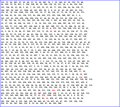This is an old revision of this page, as edited by Kukini (talk | contribs) at 13:12, 21 July 2007 (→External links: cleaning). The present address (URL) is a permanent link to this revision, which may differ significantly from the current revision.
Revision as of 13:12, 21 July 2007 by Kukini (talk | contribs) (→External links: cleaning)(diff) ← Previous revision | Latest revision (diff) | Newer revision → (diff) For the geographic code classification system, see beale code.The Beale ciphers are a set of three ciphertexts, one of which allegedly states the location of a buried treasure of gold and silver estimated to be worth over 30 million US dollars in the present time. The other two ciphertexts allegedly describe the content of the treasure, and list the names of the treasure's owners' next of kin, respectively. The story of the three ciphertexts originates from an 1885 pamphlet detailing treasure being buried by a man named Thomas Jefferson Beale in a secret location in Virginia in 1820. Beale entrusted the box containing the encrypted messages with a local innkeeper named Robert Morriss and then disappeared, never to be seen again. The innkeeper gave the three encrypted ciphertexts to a friend before he died. The friend then spent the next twenty years of his life trying to decode the messages, and was able to solve only one of them which gave details of the treasure buried and the general location of the treasure. Since the publication of the pamphlet, a number of attempts have been made to decode the two remaining ciphertexts and to find the treasure, but all have resulted in failure.
The story
- It is important to note that all of the following information originates from one source — a single pamphlet published in 1885, entitled "The Beale Papers"
The treasure was said to have been obtained by an American man named Thomas Jefferson Beale in 1818 (one of Beale's letters suggests crevice mining of metallic gold, somewhat implausibly in the claimed terrain, but nothing else is known) somewhere in what is now the American Southwest. Where exactly the treasure was found is unknown, but speculation centers to the north of Santa Fe, New Mexico, based on one of Beale's letters. Beale led about 30 adventures on the discovery, but no solid proof of either Beale, or any of his men's existence has yet been found in any public or private record.
It is claimed that Beale placed the ciphertexts in an iron box, and left it with a reliable person in 1822, a Lynchburg innkeeper, Robert Morriss, near Montvale in Bedford County, Virginia (where the treasure is said to have been buried). Beale asked him not to open that box, unless he didn't return from his journey before 10 years. Beale promised to mail Morriss the keys, but they were never received; perhaps Beale died before he could do so. Morriss on 1832 opened the box and unsuccessfully attempted to solve the ciphers on his own but, decades later, passed the box and contents (three letters and three ciphertexts), and the story, to one of his friends.
Using a particular edition of the United States Declaration of Independence as the key for a book cipher, the friend successfully deciphered the second ciphertext, which gave descriptions of the buried treasure. The friend ultimately made the letters and ciphertexts public, apparently via Jas (James?) B Ward, in an 1885 pamphlet entitled The Beale Papers. Ward is thus apparently not 'the friend'. Ward himself is obscure, and is untraceable in local records with the exception that someone of that name was the owner of the home in which a Sarah Morriss, identified as the consort of Robert Morriss, died at 77 (Lynchburg Virginian newspaper, May 21, 1861), so perhaps he was "the friend" after all. There was no explanation of the accident which led to the solution of the second ciphertext, which perhaps suggests that there was additional information now lost (from Morriss?).
The deciphered message
The plaintext reads:
- I have deposited in the county of Bedford, about four miles from Buford's, in an excavation or vault, six feet below the surface of the ground, the following articles, belonging jointly to the parties whose names are given in number "3," herewith:
- The first deposit consisted of ten hundred and fourteen pounds of gold, and thirty-eight hundred and twelve pounds of silver, deposited Nov. eighteen nineteen. The second was made December, 1821, and consisted of nineteen hundred and seven pounds of gold, and twelve hundred and eighty-eight pounds of silver; also jewels, obtained in St. Louis in exchange for silver to save transportation, and valued at US$13,000.
- The above is securely packed in iron pots, with iron covers. The vault is roughly lined with stone, and the vessels rest on solid stone, and are covered with others. Paper number "1" describes the exact locality of the vault, so that no difficulty will be had in finding it.
The second cipher can be decrypted fairly easily using any copy of the United States Declaration of Independence, but some editing for spelling is necessary.
Truth or hoax?
There has been considerable debate over whether the remaining two ciphertexts are real or hoaxes.
In 1934, Dr. Clarence Williams, a researcher at the Library of Congress, said, "To me, the pamphlet story has all the earmarks of a fake . . . no evidence save the word of the unknown author of the pamphlet that he ever had the papers."
The pamphlet's background story has several implausibilities, and is based almost entirely on circumstantial evidence and hearsay. Many cryptographers have also claimed that the two remaining ciphertexts have statistical characteristics which suggest that they are not actually encryptions of an English plaintext. Others have also questioned why Beale would have bothered writing three different ciphertexts (with at least two keys, if not ciphers) for what is essentially a single message in the first place. It is often claimed that, in many ways, the entire story seems far too implausible to be true. Some observers have noted that anachronistic use of several English terms (e.g. the word "stampede" and "improvise", not recorded before the 1840s) in the letters suggest composition no earlier than the 1840s, not the early 1820s, thus making the entire account less than credible. It is also interesting, some claim, that the second message, containing the information as to what the treasure is, has been deciphered, but the others have not. They believe that this coinicidence may be a deliberate ploy to encourage interest in deciphering the other two texts, only to discover they are hoaxes.
The third cipher is rather short, especially considering it is supposed to provide next of kin information for 30 individuals. Some have suggested that the ciphers may be legitimate codes, but do not actually contain any relevant information once "cracked" and instead simply reveal a prank message of some sort.
Regardless, there have been many attempts to break the remaining cipher(s). Most attempts have tried other historical texts as keys (eg, the Magna Carta, various books of the Bible, the U.S. Constitution, the Virginia Royal Charter, etc), assuming the ciphertexts were produced with some book cipher, but none have been recognized as successful to date. Breaking the cipher(s) may depend on random chance (as, for instance, stumbling upon a book key if the two remaining cyphertexts are actually book ciphers); so far, even the most skilled cryptanalysts who have attempted them have been defeated. Of course, Beale could have used a document that he had written himself for either or both of the remaining keys, thus rendering any further attempts to crack the codes useless.
Did Thomas J. Beale exist?
A survey of U.S. Census records in 1810 shows two persons named Thomas Beale, in Connecticut and New Hampshire. However, the population schedules from the 1810 U.S. Census are completely missing for seven states, one territory, the District of Columbia, and 18 of the counties of Virginia. The 1820 U.S. Census has two persons named Thomas Beale, in Louisiana and Tennessee, and a Thomas K. Beale in Virginia. But the population schedules are completely missing for three states and one territory.
Before 1850 the U.S. Census recorded the names of only the heads of households; others in the household were only counted, and if he existed, Beale may have been living in someone else's household.
Digging for treasure in Bedford County
Doubts have not deterred many treasure hunters, however. The 'information' that there is buried treasure in Bedford County has stimulated many an expedition with shovels, and other implements of discovery, looking for likely spots. For more than a hundred years, people have been arrested for trespassing and unauthorized digging; some of them in groups as in the case of some folks from Pennsylvania in the 1990s. The number of man made holes (up to "six feet deep" or so — see the plaintext above) in Bedford County is said to be extraordinarily large; some get filled in, some don't. County inhabitants are said to now lack enthusiasm and to generally view people with metal detectors with disfavor.
There is reportedly a story of a woman digging up a cemetery because she was convinced that Beale had hid the treasure there.
The story has been the subject of at least two television documentaries (one is in the UK's Mysteries series), several books, and considerable Internet activity. There is even a 2001 claim (and supporting Web site) of having decrypted one of the remaining cipher texts and of finding the Beale vault — minus its supposed treasure (and any explanation of the cryptanalysis).
See also
- List of famous ciphertexts
- Rennes-le-Château - a version of the story in France, where a set of encrypted documents discovered in a local church, allegedly refer to a hidden treasure
Books and articles
- Viemeister, Peter. The Beale Treasure: New History of a Mystery, 1997. Published by Hamilton's, Bedford, Virginia
- Gillogly, James J.. "The Beale Cipher: A Dissenting Opinion", April 1980, Cryptologia, Volume 4, Number 2
- Dunin, Elonka. The Mammoth Book of Secret Codes and Cryptograms, 2006. US ISBN 0-7867-1726-2, UK ISBN 1-84529-325-8. Contains the complete text of The Beale Papers
References
- "The Beale Treasure Ciphers". The Guardian. 1999. Retrieved 2007-04-14.
- Elonka Dunin (December 8, 2003). "Famous Unsolved Codes and Ciphers". Retrieved 2007-04-14.
- The Beale Cipher: A Dissenting Opinion, James Gillogly, Cryptologia, April 1980
- The Beale Ciphers, George Love
- A Basic Probe of the Beale Cipher as Bamboozlement, Louis Kruh, Cryptologia, October 1982 (PDF file, 70 kB)
- See: Missing Federal Census Schedules.
- National Archives and Records Administration, Clues in Census Records, 1790-1840.
External links
- The Legendary Beale Treasure
- Overview of some of the literature on the Beale ciphers
- List of World's Most Famous Unsolved Codes (Beale Ciphers are #1) maintained by Elonka Dunin
- A suggested solution for the ciphers and supposed vault photos
- The Beale Papers Hoax
- Attack on the Beale Ciphers - Summary in english (Historical background and bibliography in french)
- An online Beale Cipher Encoder/Decoder


